It’s tough to build up leg muscles, especially the calves. The bodyweight exercises are an effective way to build calf muscle at home.
Calf exercises are often part of training programs to increase the size of the calf muscles. However, training the calves also proves important in daily activities, as it improves the force of plantarflexion and dorsiflexion.
Plantarflexion and dorsiflexion are movements required in almost all sporting events, such as jumping, sprinting, changing direction, standing on the tips of the toes, and pressing down on the car pedals while driving.
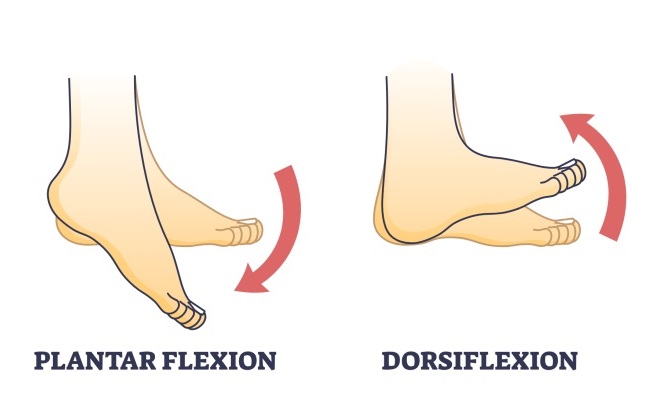
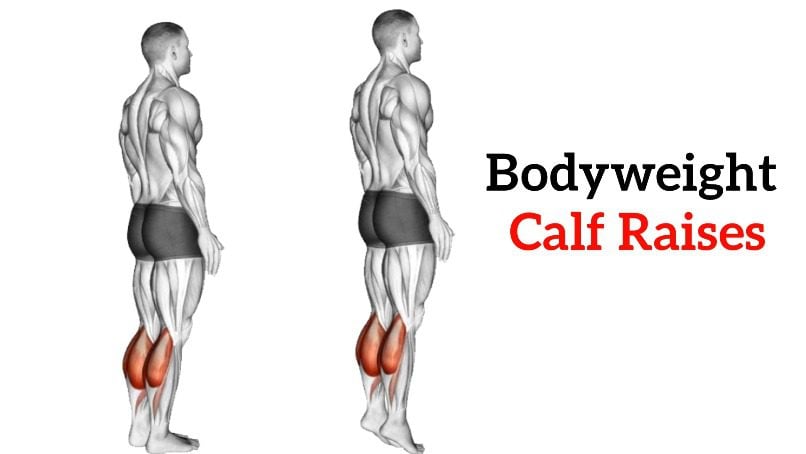
- What is Bodyweight Calf Raises
- Bodyweight Calf Raises Muscles Worked
- How to Do Bodyweight Standing Calf Raise
- Tips and Forms To Build Bigger Calf
- 4. Variations of Bodyweight calf raise Exercises
- 1. Bodyweight Floor Calf Raise
- 2. Donkey Calf Raise
- 3. Single Leg Standing Calf Raise
- 4. Squat Hold Calf Raise
- Bodyweight calf raise Benefits
- Takeaways
What is Bodyweight Calf Raises
Standing bodyweight calf raises (also known as heel raises) are a classic move for strengthening the calves, particularly the gastrocnemius and soleus.
It is an easy exercise. You can do it at home or pretty much anywhere because it only uses your body weight.
Calf muscles are not usually trained as much as upper body muscles. This is because people usually neglect to train them due to their inconspicuous actions. As a result, muscle development slows down due to insufficient training intensity.
Remember to include enough muscle contractions, frequency, and variations in the calf workout routine to build muscle size and strength.
Here are the best ways to do standing calf raises with your bodyweight.
- Single Leg Standing Calf Raises
- Seated Calf Raises
- Donkey Calf Raises
- Squat Hold Calf Raises
- Jumping Calf Raise
Bodyweight Calf Raises Muscles Worked
When performing calf raises, several muscles are worked, primarily in the lower leg.
The main muscles targeted during calf raises include:
- Gastrocnemius
- Soleus
- Plantaris
- Tibialis anterior and posterior
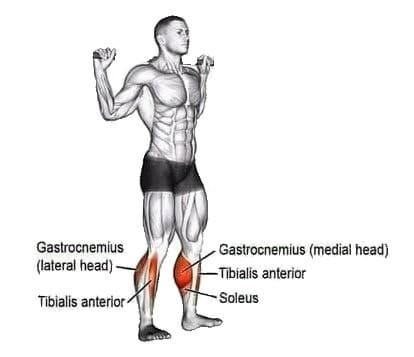
How to Do Bodyweight Standing Calf Raise
- Stand up straight with your feet facing forward and hip-width apart.
- Keep your core engaged, and bend your knees slightly.
- You can lightly place your hands on a wall or any available support for additional stability.
- Raise your heels by pressing the balls of your feet into the ground.
- You should raise your body until you are on your toes.
- At the top of the movement, gently squeeze your calf muscles for a brief pause.
- Slowly lower your heels back towards the ground.
- At the bottom, allow your heels to briefly drop slightly below the level of the balls of your feet to achieve a good stretch in the calves.
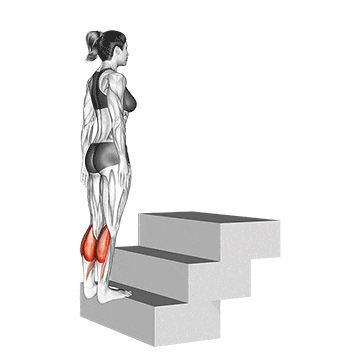
Tips and Forms To Build Bigger Calf
- Keep your knees slightly bent; don’t lock them out.
- Keep your torso upright and your core engaged. Avoid leaning forward or backward as you lift.
- Pause and squeeze for a count of 1-2 at the movement’s top for added intensity.
- Exhale while you exert, in this case, while raising your calves against resistance.
- Keep the balls of your feet on the edge of the block/step. If you allow the balls of your feet to come in more, the exercise becomes easier.
- You must go through full-range movements to target the calve muscles, including both the gastrocnemius and soleus muscles. Since partial calf movements happen every day when walking and running,
- Start with 2–3 sets of 10–15 repetitions, and gradually increase the volume and intensity.
- Pause and squeeze for a count of 1-2 at the movement’s top for added intensity.
- Set calves are a high priority; treat them that way by training them first on leg day.
- Emphasize high volume and perform at least 20 reps per set. Keep it under 20-25 reps per set.
- Include one standing and one seated exercise per calf workout.
- If you want to grow your calf, you need to focus on the squeeze and contraction—i.e., the top part of the movement.
- For stronger or bigger calves, maintain a slow, controlled tempo.
- Hold a dumbbell or weight plate in front of your body to add resistance and further challenge your calves.
Want to take your gains to the next level? Discover your daily calorie needs with our free TDEE calculator
4. Variations of Bodyweight calf raise Exercises
There are several ways to do bodyweight calf raises, depending on your fitness level.
- If you are new to performing a bodyweight calf raise, you may want to apply a few modifications to make the exercise easier. One way to counter this problem is to do chair-supported calf raises or floor calf raises.
- If you want a more advanced variation of bodyweight calf raises, you can do Squat Hold Calf Raises and single-leg calf raises. You could also make it more challenging by using weights.
Read More To Know More: Bodyweight Leg Exercises For Mass, Strength And Power
1. Bodyweight Floor Calf Raise
The first and most common form of calf exercise for beginners is the standing floor calf raise. This simple isolation movement requires no equipment and effectively targets your calf muscles.

How To Do
- Stand with your feet shoulder-width apart, toes facing forward. Engage your core.
- Lift your heels off the ground by shifting your weight onto the balls of your feet and lifting your weight onto the balls.
- Pause briefly at the top of the movement, then slowly lower your heels back down to the floor.
2. Donkey Calf Raise
Donkey calf raises are an excellent bodyweight calf raise exercise for building calf muscles. This is usually the second choice of many athletes after standing calf raises.
The donkey calf raises primarily engages the two muscles that comprise the calves: the gastrocnemius and the soleus.
It secondarily activates the hamstrings and abs. When you bend over to initiate the calf raise, the hamstrings receive a stretch.
This exercise is done with a training partner sitting across your back.
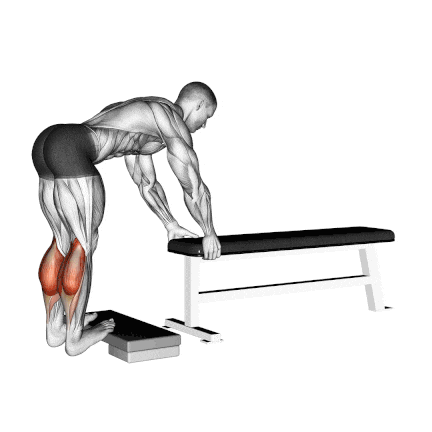
How To Do
- Stand on a board and bend forward, holding a table for support.
- Ask a training partner to sit across your back.
- Lower your heels, get as low as possible, and fully contract your calf muscles.
- Extend your calves and get back to the starting position.
- Use high blocks to ensure you are not limited in the range of your movements.
3. Single Leg Standing Calf Raise
Single-leg standing calf raises work both the gastrocnemius and soleus muscles through a full range of motion.
You can perform it by standing on the floor and on the edge of an elevated platform, such as a step on the stairs, with your hands placed on the railing for stability.
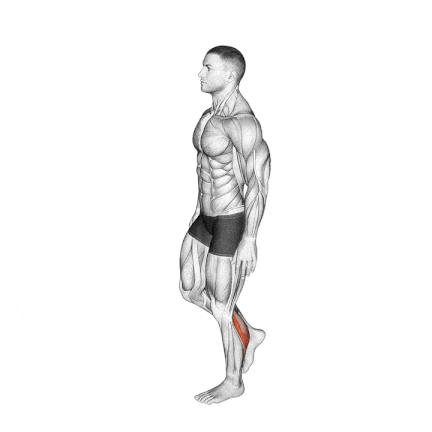
How To Do
- Stand up straight on one foot (Say right foot). Cross your left ankle behind your right.
- Keep a slight bend in your knee and hold your hands by your side or on the railing for stabilization.
- Raise your heel by pressing the balls of your feet into the ground.
- You should move your body upwards until you’re standing on your toes.
- Hold this position for one to two seconds, and then slowly lower your heels back to the ground.
4. Squat Hold Calf Raise
Squat-hold calf raises work the soleus muscles more than the gastrocnemius muscles, but the former still makes a lot of force.
To complete this exercise, you should assume a squat position with feet shoulder-width apart and hands in front or placed on the hips.
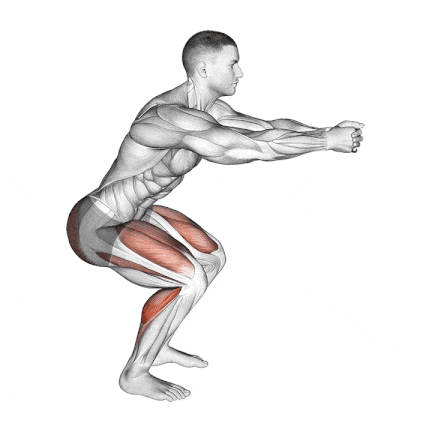
How To Do
- Stand with your feet about three to four feet apart, toes turned out.
- Bring your hands together in front of your chest.
- Keep your abs tight and your back straight, and maintain your knees aligned with your toes.
- Squat down by bending at the knees and hips, letting your glutes track backward to lower yourself into a squat.
- Raise your heel off the floor and squeeze your calves.
- Repeat until the set is complete.
Bodyweight calf raise Benefits
Body weight calf raises are simple and effective exercises that can benefit many.
- Since the calves are used extensively while walking, running, jumping, and moving your body during functional movements, training them with calf-dominated exercises is important.
- Training your calves is particularly important to build calves strength, endurance, and explosiveness. It’s great for improving ankle stability and overall balance.
- Strengthening your muscles will allow you to increase your vertical jump, like in burpees, and reduce the impact on your knee joints.
- Calf raises help to strengthen ankle muscles, which are critical to prevent injury.
- Strong calves are also significant for performing plyometric and power exercises properly.
- If you are passionate about running but are afraid of injury, consider regularly doing calf raises. They can reduce the likelihood of injury and increase your speed.
- It allows unilateral training (training one limb at a time), increases core stability for athletes, and improves any muscular imbalances.
- Bodyweight calf raise exercises are perfect for the at-home exerciser with limited space.
Takeaways
Bodyweight calf raise exercises targeting the calf muscles are beneficial for individuals wanting to increase lower leg size and the general population.
Whether you are just beginning your fitness journey or are already very fit, there are calf exercises that you can do at every workout to help you achieve your goals.
References
- Arampatzis A, Karamanidis K, Albracht K. Adaptational responses of the human Achilles tendon by modulation of the applied cyclic strain magnitude. J Exp Biol 210: 2743–2753, 2007. doi: 10.1242/jeb.003814.
- Ema R, Ohki S, Takayama H, Kobayashi Y, Akagi R. Effect of calf-raise training on rapid force production and balance ability in elderly men. J Appl Physiol (1985). 2017 Aug 1;123(2):424-433.
- Vissing, K., Brink, M., Lønbro, S. et al. Muscle Adaptations to Plyometric vs. Resistance Training in Untrained Young Men. Journal of Strength and Conditioning Research:
- Ema R, Saito M, Ohki S, Takayama H, Yamada Y, Akagi R. Association between rapid force production by the plantar flexors and balance performance in elderly men and women. Age (Dordr) 38: 475–483, 2016. doi: 10.1007/s11357-016-9949-3.

Manish brings over 10 years of hands-on experience in weight lifting and fat loss to fitness coaching. He specializes in gym-based training and has a lot of knowledge about exercise, lifting technique, biomechanics, and more.
Through “Fit Life Regime,” he generously shares the insights he’s gained over a decade in the field. His goal is to equip others with the knowledge to start their own fitness journey.
